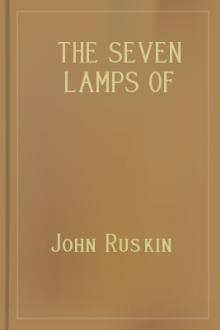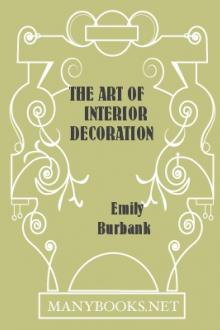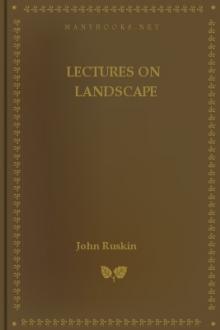The Seven Lamps of Architecture by John Ruskin (books like harry potter TXT) 📕

- Author: John Ruskin
- Performer: -
Book online «The Seven Lamps of Architecture by John Ruskin (books like harry potter TXT) 📕». Author John Ruskin
Ornament, as I have often before observed, has two entirely distinct sources of agreeableness: one, that of the abstract beauty of its forms, which, for the present, we will suppose to be the same whether they come from the hand or the machine; the other, the sense of human labor and care spent upon it. How great this latter influence we may perhaps judge, by considering that there is not a cluster of weeds growing in any cranny of ruin which has not a beauty in all respects nearly equal, and, in some, immeasurably superior, to that of the most elaborate sculpture of its stones: and that all our interest in the carved work, our sense of its richness, though it is tenfold less rich than the knots of grass beside it; of its delicacy, though it is a thousand fold less delicate; of its admirableness, though a millionfold less admirable; results from our consciousness of its being the work of poor, clumsy, toilsome man. Its true delightfulness depends on our discovering in it the record of thoughts, and intents, and trials, and heart-breakings—of recoveries and joyfulnesses of success: all this can be traced by a practised eye; but, granting it even obscure, it is presumed or understood; and in that is the worth of the thing, just as much as the worth of anything else we call precious. The worth of a diamond is simply the understanding of the time it must take to look for it before it can be cut. It has an intrinsic value besides, which the diamond has not (for a diamond has no more real beauty than a piece of glass); but I do not speak of that at present; I place the two on the same ground; and I suppose that hand-wrought ornament can no more be generally known from machine work, than a diamond can be known from paste; nay, that the latter may deceive, for a moment, the mason's, as the other the jeweller's eye; and that it can be detected only by the closest examination. Yet exactly as a woman of feeling would not wear false jewels, so would a builder of honor disdain false ornaments. The using of them is just as downright and inexcusable a lie. You use that which pretends to a worth which it has not; which pretends to have cost, and to be, what it did not, and is not; it is an imposition, a vulgarity, an impertinence, and a sin. Down with it to the ground, grind it to powder, leave its ragged place upon the wall, rather; you have not paid for it, you have no business with it, you do not want it. Nobody wants ornaments in this world, but everybody wants integrity. All the fair devices that ever were fancied, are not worth a lie. Leave your walls as bare as a planed board, or build them of baked mud and chopped straw, if need be; but do not rough-cast them with falsehood.
This, then, being our general law, and I hold it for a more imperative one than any other I have asserted; and this kind of dishonesty the meanest, as the least necessary; for ornament is an extravagant and inessential thing; and, therefore, if fallacious, utterly base—this, I say, being our general law, there are, nevertheless, certain exceptions respecting particular substances and their uses.
XX. Thus in the use of brick; since that is known to be originally moulded, there is no reason why it should not be moulded into diverse forms. It will never be supposed to have been cut, and therefore, will cause no deception; it will have only the credit it deserves. In flat countries, far from any quarry of stone, cast brick may be legitimately, and most successfully, used in decoration, and that elaborate, and even refined. The brick mouldings of the Palazzo Pepoli at Bologna, and those which run round the market-place of Vercelli, are among the richest in Italy. So also, tile and porcelain work, of which the former is grotesquely, but successfully, employed in the domestic architecture of France, colored tiles being inserted in the diamond spaces between the crossing timbers; and the latter admirably in Tuscany, in external bas-reliefs, by the Robbia family, in which works, while we cannot but sometimes regret the useless and ill-arranged colors, we would by no means blame the employment of a material which, whatever its defects, excels every other in permanence, and, perhaps, requires even greater skill in its management than marble. For it is not the material, but the absence of the human labor, which makes the thing worthless; and a piece of terra cotta, or of plaster of Paris, which has been wrought by human hand, is worth all the stone in Carrara, cut by machinery. It is, indeed, possible, and even usual, for men to sink into machines themselves, so that even hand-work has all the characters of mechanism; of the difference between living and dead hand-work I shall speak presently; all that I ask at present is, what it is always in our power to secure—the confession of what we have done, and what we have given; so that when we use stone at all, since all stone is naturally supposed to be carved by hand, we must not carve it by machinery; neither must we use any artificial stone cast into shape, nor any stucco ornaments of the color of stone, or which might in anywise be mistaken for it, as the stucco mouldings in the cortile of the Palazzo Vecchio at Florence, which cast a shame and suspicion over every part of the building. But for ductile and fusible materials, as clay, iron, and bronze, since these will usually be supposed to have been cast or stamped, it is at our pleasure to employ them as we will; remembering that they become precious, or otherwise, just in proportion to the hand-work upon them, or to the clearness of their reception of the hand-work of their mould.
But I believe no cause to have been more active in the degradation of our natural feeling for beauty, than the constant use of cast iron ornaments. The common iron work of the middle ages was as simple as it was effective, composed of leafage cut flat out of sheet iron, and twisted at the workman's will. No ornaments, on the contrary, are so cold, clumsy, and vulgar, so essentially incapable of a fine line, or shadow, as those of cast iron; and while, on the score of truth, we can hardly allege anything against them, since they are always distinguishable, at a glance, from wrought and hammered work, and stand only for what they are, yet I feel very strongly that there is no hope of the progress of the arts of any nation which indulges in these vulgar and cheap substitutes for real decoration. Their inefficiency and paltriness I shall endeavor to show more conclusively in another place, enforcing only, at present, the general conclusion that, if even honest or allowable, they are things in which we can never take just pride or pleasure, and must never be employed in any place wherein they might either themselves obtain the credit of being other and better than they are, or be associated with the downright work to which it would be a disgrace to be found in their company.
Such are, I believe, the three principal kinds of fallacy by which architecture is liable to be corrupted; there are, however, other and more subtle forms of it, against which it is less easy to guard by definite law, than by the watchfulness of a manly and unaffected spirit. For, as it has been above noticed, there are certain kinds of deception which extend to impressions and ideas only; of which some are, indeed, of a noble use, as that above referred to, the arborescent look of lofty Gothic aisles; but of which the most part have so much of legerdemain and trickery about them, that they will lower any style in which they considerably prevail; and they are likely to prevail when once they are admitted, being apt to catch the fancy alike of uninventive architects and feelingless spectators; just as mean and shallow minds are, in other matters, delighted with the sense of over-reaching, or tickled with the conceit of detecting the intention to over-reach; and when subtleties of this kind are accompanied by the display of such dextrous stone-cutting, or architectural sleight of hand, as may become, even by itself, a subject of admiration, it is a great chance if the pursuit of them do not gradually draw us away from all regard and care for the nobler character of the art, and end in its total paralysis or extinction. And against this there is no guarding, but by stern disdain of all display of dexterity and ingenious device, and by putting the whole force of our fancy into the arrangement of masses and forms, caring no more how these masses and forms are wrought out, than a great painter cares which way his pencil strikes. It would be easy to give many instances of the danger of these tricks and vanities; but I shall confine myself to the examination of one which has, as I think, been the cause of the fall of Gothic architecture throughout Europe. I mean the system of intersectional mouldings, which, on account of its great importance, and for the sake of the general reader, I may, perhaps, be pardoned for explaining elementarily.
XXI. I must, in the first place, however, refer to Professor Willis's account of the origin of tracery, given in the sixth chapter of his Architecture of the Middle Ages; since the publication of which I have been not a little amazed to hear of any attempts made to resuscitate the inexcusably absurd theory of its derivation from imitated vegetable form—inexcusably, I say, because the smallest acquaintance with early Gothic architecture would have informed the supporters of that theory of the simple fact, that, exactly in proportion to the antiquity of the work, the imitation of such organic forms is less, and in the earliest examples does not exist at all. There cannot be the shadow of a question, in the mind of a person familiarised with any single series of consecutive examples, that tracery arose from the gradual enlargement of the penetrations of the shield of stone which, usually supported by a central pillar, occupied the head of early windows. Professor Willis, perhaps, confines his observations somewhat too absolutely to the double sub-arch. I have given, in Plate VII. fig. 2, an interesting case of rude penetration of a high and simply trefoiled shield, from the church of the Eremitani at Padua. But the more frequent and typical form is that of the double sub-arch, decorated with various piercings of the space between it and the superior arch; with a simple trefoil under a round arch, in the Abbaye aux Hommes, Caen9 (Plate III. fig. 1); with a very beautifully proportioned quatrefoil, in the triforium of Eu, and that of the choir of Lisieux; with quatrefoils, sixfoils, and septfoils, in the transept towers of Rouen (Plate III. fig. 2); with a trefoil awkwardly, and very small quatrefoil above, at Coutances, (Plate III. fig. 3); then, with multiplications of the same figures, pointed or round, giving very clumsy shapes of the intermediate stone (fig. 4, from one of the nave chapels of Rouen, fig. 5, from one of the nave chapels of Bayeaux), and finally, by thinning out the stony ribs, reaching conditions like that of the glorious typical form of the clerestory of the apse of Beauvais (fig. 6).





Comments (0)